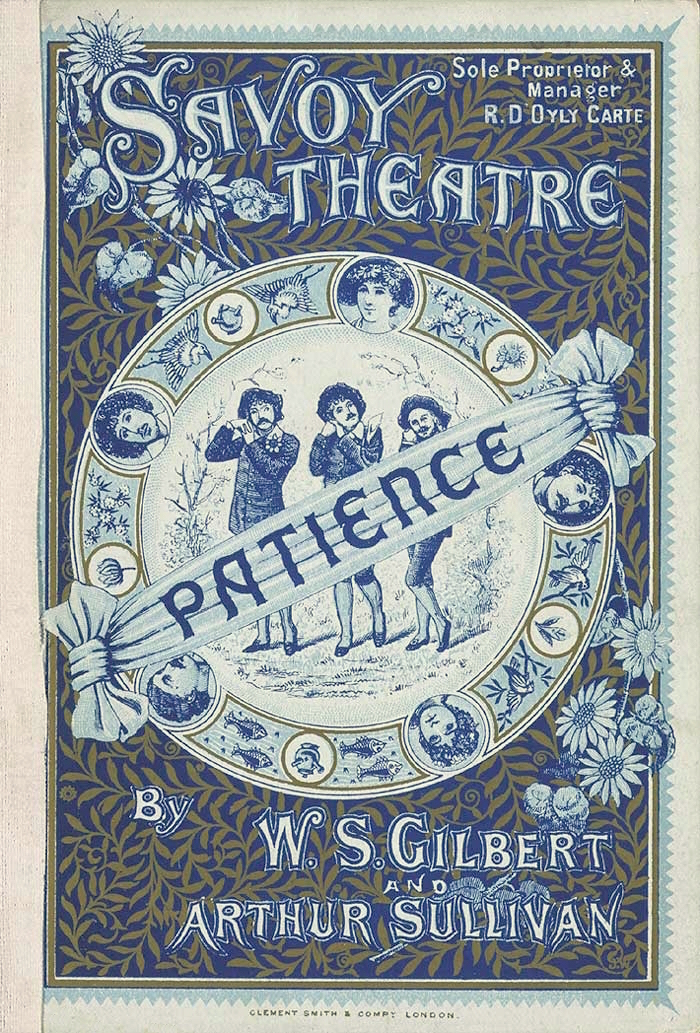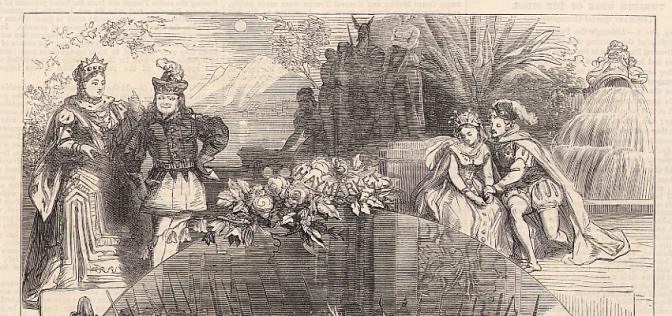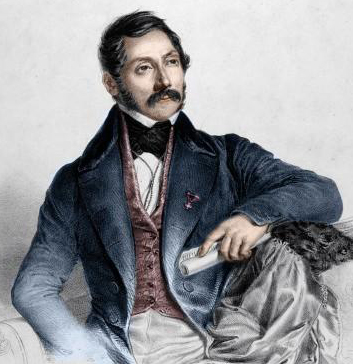|
Robert The Devil (Gilbert)
''Robert the Devil, or The Nun, the Dun, and the Son of a Gun'' is an operatic parody by W. S. Gilbert of Giacomo Meyerbeer's grand opera ''Robert le diable'', which was named after, but bears little resemblance to, the medieval French legend of the same name. Gilbert set new lyrics to tunes by Meyerbeer, Bellini, Offenbach and others. The piece premiered at the opening of the newly rebuilt Gaiety Theatre in London on 21 December 1868. An extravaganza played on a very large scale, it ran for over 120 performances and played continuously in the British provinces for three years thereafter. It also enjoyed several revivals. The original production starred Nellie Farren in the title role – she became the company's leading "principal boy". Several of the other male roles were played by women, as was common in burlesques of the day. History ''Robert the Devil'' was part of a series of five operatic burlesques written early in Gilbert's career. The first was ''Dulcamara, or the ... [...More Info...] [...Related Items...] OR: [Wikipedia] [Google] [Baidu] |
The Merry Zingara
''The Merry Zingara; Or, The Tipsy Gipsy & The Pipsy Wipsy'' was the third of W. S. Gilbert's five burlesques of opera. Described by the author as "A Whimsical Parody on ''The Bohemian Girl''", by Michael Balfe, it was produced at the Royalty Theatre, London, on 21 March 1868. As in his four other operatic parodies written early in his career, Gilbert selected operatic and popular tunes from a variety of sources, and fitted new words to them. Although he used only one tune from Balfe's original, ''The Merry Zingara'' is the burlesque in which Gilbert's libretto stays closest to the original work. The cast of characters is nearly the same, as is the plot. In his lyrics, too, Gilbert paid great attention to the speech-patterns of his originals. Although, as contemporary critics repeatedly remarked, the libretti of Gilbert's burlesques were more literate and intelligent than those of most of the genre, he nonetheless followed the conventional formula of rhyming couplets and tortuou ... [...More Info...] [...Related Items...] OR: [Wikipedia] [Google] [Baidu] |
Travesti (theatre)
''Travesti'' is a theatrical term referring to the portrayal of a character in an opera, play, or ballet by a performer of the opposite sex. For social reasons, female roles were played by boys or men in many early forms of theatre, and ''travesti'' roles continued to be used in several types of context even after actresses became accepted on the stage. The popular British theatrical form of the pantomime traditionally contains a role for a " principal boy", a breeches role played by a young woman, and also one or more pantomime dames, female comic roles played by men. Similarly, in the formerly popular genre of Victorian burlesque, there were usually one or more breeches roles. Etymology The word means "disguised" in French. Depending on sources, the term may be given as travesty, ''travesti'', or ''en travesti''. The ''Oxford Essential Dictionary of Foreign Terms in English'' explains the origin of the latter term as "pseudo- French", although French sources from the mid-19th ... [...More Info...] [...Related Items...] OR: [Wikipedia] [Google] [Baidu] |
Breeches Role
A breeches role (also pants role or trouser role, or Hosenrolle) is one in which an actress appears in male clothing. Breeches, tight-fitting knee-length pants, were the standard male garment at the time these roles were introduced. The theatrical term ''travesti'' covers both this sort of cross-dressing and also that of male actors dressing as female characters. Both are part of the long history of cross-dressing in music and opera and later in film and television. In opera, a breeches role refers to any male character that is sung and acted by a female singer. Most often the character is an adolescent or a very young man, sung by a mezzo-soprano or contralto. Budden J., "Breeches part" in: ''The New Grove Dictionary of Opera''. Macmillan, London and New York, 1997. The operatic concept assumes that the character is male, and the audience accepts him as such, even knowing that the actor is not. Cross-dressing female characters (e.g., Leonore in ''Fidelio'' or Gilda in Act III ... [...More Info...] [...Related Items...] OR: [Wikipedia] [Google] [Baidu] |
Savoy Opera
Savoy opera was a style of comic opera that developed in Victorian England in the late 19th century, with W. S. Gilbert and Arthur Sullivan as the original and most successful practitioners. The name is derived from the Savoy Theatre, which impresario Richard D'Oyly Carte built to house the Gilbert and Sullivan pieces, and later those by other composer–librettist teams. The great bulk of the non-G&S Savoy Operas either failed to achieve a foothold in the standard repertory, or have faded over the years, leaving the term "Savoy Opera" as practically synonymous with Gilbert and Sullivan. The Savoy operas (in both senses) were seminal influences on the creation of the modern musical. Gilbert, Sullivan, Carte and other Victorian era British composers, librettists and producers, as well as the contemporary British press and literature, called works of this kind "comic operas" to distinguish their content and style from that of the often risqué continental European operettas that th ... [...More Info...] [...Related Items...] OR: [Wikipedia] [Google] [Baidu] |
Gilbert And Sullivan
Gilbert and Sullivan was a Victorian era, Victorian-era theatrical partnership of the dramatist W. S. Gilbert (1836–1911) and the composer Arthur Sullivan (1842–1900), who jointly created fourteen comic operas between 1871 and 1896, of which ''H.M.S. Pinafore'', ''The Pirates of Penzance'' and ''The Mikado'' are among the best known.Davis, Peter G''Smooth Sailing'' ''New York'' magazine, 21 January 2002, accessed 6 November 2007 Gilbert, who wrote the libretti for these operas, created fanciful "topsy-turvy" worlds where each absurdity is taken to its logical conclusion; fairies rub elbows with British lords, flirting is a capital offence, gondoliers ascend to the monarchy, and pirates emerge as noblemen who have gone astray.Mike Leigh, Leigh, Mike"True anarchists" ''The Guardian'', 4 November 2007, accessed 6 November 2007 Sullivan, six years Gilbert's junior, composed the music, contributing memorable melodies that could convey both humour and pathos. Their operas have enj ... [...More Info...] [...Related Items...] OR: [Wikipedia] [Google] [Baidu] |
Pygmalion And Galatea (play)
''Pygmalion and Galatea, an Original Mythological Comedy'' is a blank verse play by W. S. Gilbert in three acts based on the Pygmalion story. It opened at the Haymarket Theatre in London on 9 December 1871 and ran for a very successful 184 performances.Moss, Simon"Pygmalion and Galatea"at ''Gilbert & Sullivan: a selling exhibition of memorabilia'', c20th.com, accessed 16 November 2009 It was revived many times, including an 1883 production in New York starring Mary Anderson as Galatea, an 1883–84 revival at the Lyceum Theatre, again with Anderson, and an 1888 production at the Lyceum Theatre, with Julia Neilson as Cynisca. ''Pygmalion'' was Gilbert's greatest success to that date and is said to have earned him £40,000 during his lifetime. ''Pygmalion and Galatea'' was so popular that other Pygmalions were rushed to the stage. In January 1872, ''Ganymede and Galatea'' opened at the Gaiety Theatre. This was a comic version of Franz von Suppé's '' Die schöne Galathee'', c ... [...More Info...] [...Related Items...] OR: [Wikipedia] [Google] [Baidu] |
The Palace Of Truth
''The Palace of Truth'' is a three-act blank verse "Fairy Comedy" by W. S. Gilbert first produced at the Haymarket Theatre in London on 19 November 1870, adapted in significant part from Madame de Genlis's fairy story, ''Le Palais de Vérite''. The play ran for approximately 140 performances and then toured the British provinces and enjoyed various revivals even well into the 20th century. There was also a New York production in 1910. After more than a century of inquiry, researchers in 2012 concluded that the three genera of Lemurs were named after characters in ''The Palace of Truth'' in 1870 by British zoologist John Edward Gray. Background Gilbert created several blank verse "fairy comedies" at the Haymarket Theatre for actor-manager John Baldwin Buckstone and starring William Hunter Kendal and his wife Madge Robertson Kendal (sister of the playwright Tom Robertson) in the early 1870s. These plays, influenced by the fairy works of James Planché, are founded upon the idea o ... [...More Info...] [...Related Items...] OR: [Wikipedia] [Google] [Baidu] |
Pantomime
Pantomime (; informally panto) is a type of musical comedy stage production designed for family entertainment. It was developed in England and is performed throughout the United Kingdom, Ireland and (to a lesser extent) in other English-speaking countries, especially during the Christmas and New Year season. Modern pantomime includes songs, gags, slapstick comedy and dancing. It employs gender-crossing actors and combines topical humour with a story more or less based on a well-known fairy tale, fable or folk tale.Reid-Walsh, Jacqueline. "Pantomime", ''The Oxford Encyclopedia of Children's Literature'', Jack Zipes (ed.), Oxford University Press (2006), Pantomime is a participatory form of theatre, in which the audience is encouraged and expected to sing along with certain parts of the music and shout out phrases to the performers. Pantomime has a long theatrical history in Western culture dating back to the era of classical theatre. It developed partly from the 16th century c ... [...More Info...] [...Related Items...] OR: [Wikipedia] [Google] [Baidu] |
The Times
''The Times'' is a British daily national newspaper based in London. It began in 1785 under the title ''The Daily Universal Register'', adopting its current name on 1 January 1788. ''The Times'' and its sister paper ''The Sunday Times'' (founded in 1821) are published by Times Newspapers, since 1981 a subsidiary of News UK, in turn wholly owned by News Corp. ''The Times'' and ''The Sunday Times'', which do not share editorial staff, were founded independently and have only had common ownership since 1966. In general, the political position of ''The Times'' is considered to be centre-right. ''The Times'' is the first newspaper to have borne that name, lending it to numerous other papers around the world, such as ''The Times of India'', ''The New York Times'', and more recently, digital-first publications such as TheTimesBlog.com (Since 2017). In countries where these other titles are popular, the newspaper is often referred to as , or as , although the newspaper is of nationa ... [...More Info...] [...Related Items...] OR: [Wikipedia] [Google] [Baidu] |
Norma (opera)
''Norma'' () is a ''tragedia lirica'' or opera in two acts by Vincenzo Bellini with libretto by Felice Romani after the play ''Norma, ou L'infanticide'' (''Norma, or The Infanticide'') by Alexandre Soumet. It was first produced at La Scala in Milan on 26 December 1831. The opera is regarded as a leading example of the bel canto genre, and the soprano prayer "Casta diva" in act 1 is a famous piece. Among the well known singers of Norma of the first half of the 20th century was Rosa Ponselle who played the role in New York and London. Notable exponents of the title role in the post-war period have been Maria Callas, Leyla Gencer, Joan Sutherland, and Montserrat Caballé. Composition history Crivelli and Company were managing both La Scala and La Fenice in Venice, and as a result, in April–May 1830 Bellini was able to negotiate a contract with them for two operas, one at each theatre. The opera for December 1831 at La Scala became ''Norma'', while the one for the 1832 Carnival ... [...More Info...] [...Related Items...] OR: [Wikipedia] [Google] [Baidu] |




.jpg)




